Henry Weld
Tri-level Joint Natural Language Understanding for Multi-turn Conversational Datasets
May 28, 2023Abstract:Natural language understanding typically maps single utterances to a dual level semantic frame, sentence level intent and slot labels at the word level. The best performing models force explicit interaction between intent detection and slot filling. We present a novel tri-level joint natural language understanding approach, adding domain, and explicitly exchange semantic information between all levels. This approach enables the use of multi-turn datasets which are a more natural conversational environment than single utterance. We evaluate our model on two multi-turn datasets for which we are the first to conduct joint slot-filling and intent detection. Our model outperforms state-of-the-art joint models in slot filling and intent detection on multi-turn data sets. We provide an analysis of explicit interaction locations between the layers. We conclude that including domain information improves model performance.
Spoken Language Understanding for Conversational AI: Recent Advances and Future Direction
Dec 21, 2022
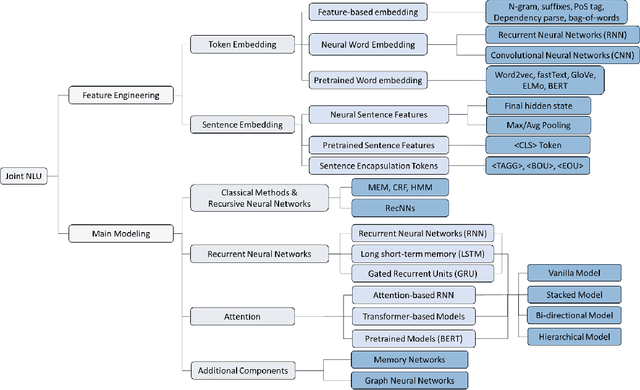
Abstract:When a human communicates with a machine using natural language on the web and online, how can it understand the human's intention and semantic context of their talk? This is an important AI task as it enables the machine to construct a sensible answer or perform a useful action for the human. Meaning is represented at the sentence level, identification of which is known as intent detection, and at the word level, a labelling task called slot filling. This dual-level joint task requires innovative thinking about natural language and deep learning network design, and as a result, many approaches and models have been proposed and applied. This tutorial will discuss how the joint task is set up and introduce Spoken Language Understanding/Natural Language Understanding (SLU/NLU) with Deep Learning techniques. We will cover the datasets, experiments and metrics used in the field. We will describe how the machine uses the latest NLP and Deep Learning techniques to address the joint task, including recurrent and attention-based Transformer networks and pre-trained models (e.g. BERT). We will then look in detail at a network that allows the two levels of the task, intent classification and slot filling, to interact to boost performance explicitly. We will do a code demonstration of a Python notebook for this model and attendees will have an opportunity to watch coding demo tasks on this joint NLU to further their understanding.
Bi-directional Joint Neural Networks for Intent Classification and Slot Filling
Feb 26, 2022


Abstract:Intent classification and slot filling are two critical tasks for natural language understanding. Traditionally the two tasks proceeded independently. However, more recently joint models for intent classification and slot filling have achieved state-of-the-art performance, and have proved that there exists a strong relationship between the two tasks. In this paper, we propose a bi-directional joint model for intent classification and slot filling, which includes a multi-stage hierarchical process via BERT and bi-directional joint natural language understanding mechanisms, including intent2slot and slot2intent, to obtain mutual performance enhancement between intent classification and slot filling. The evaluations show that our model achieves state-of-the-art results on intent classification accuracy, slot filling F1, and significantly improves sentence-level semantic frame accuracy when applied to publicly available benchmark datasets, ATIS (88.6%) and SNIPS (92.8%).
CONDA: a CONtextual Dual-Annotated dataset for in-game toxicity understanding and detection
Jun 11, 2021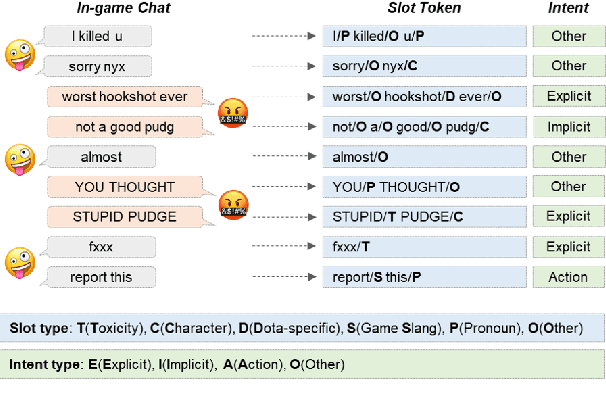
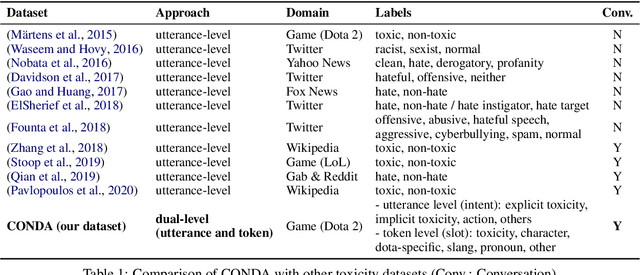
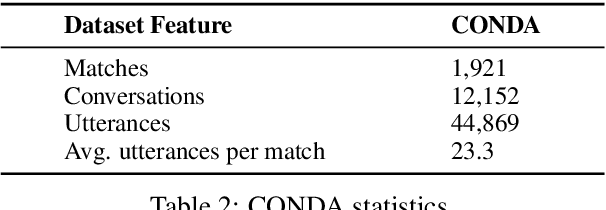
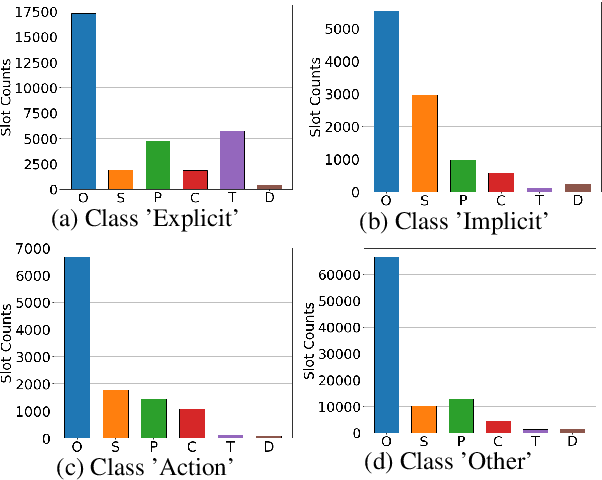
Abstract:Traditional toxicity detection models have focused on the single utterance level without deeper understanding of context. We introduce CONDA, a new dataset for in-game toxic language detection enabling joint intent classification and slot filling analysis, which is the core task of Natural Language Understanding (NLU). The dataset consists of 45K utterances from 12K conversations from the chat logs of 1.9K completed Dota 2 matches. We propose a robust dual semantic-level toxicity framework, which handles utterance and token-level patterns, and rich contextual chatting history. Accompanying the dataset is a thorough in-game toxicity analysis, which provides comprehensive understanding of context at utterance, token, and dual levels. Inspired by NLU, we also apply its metrics to the toxicity detection tasks for assessing toxicity and game-specific aspects. We evaluate strong NLU models on CONDA, providing fine-grained results for different intent classes and slot classes. Furthermore, we examine the coverage of toxicity nature in our dataset by comparing it with other toxicity datasets.
 Add to Chrome
Add to Chrome Add to Firefox
Add to Firefox Add to Edge
Add to Edge